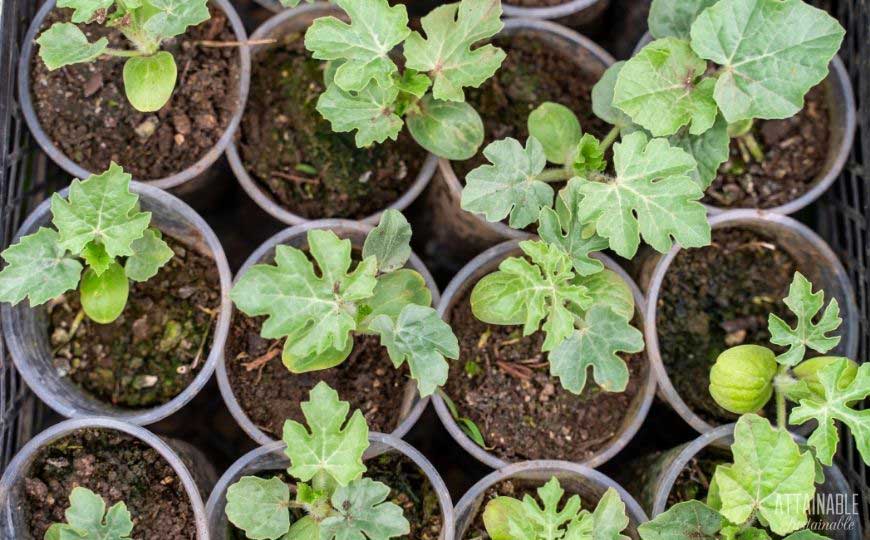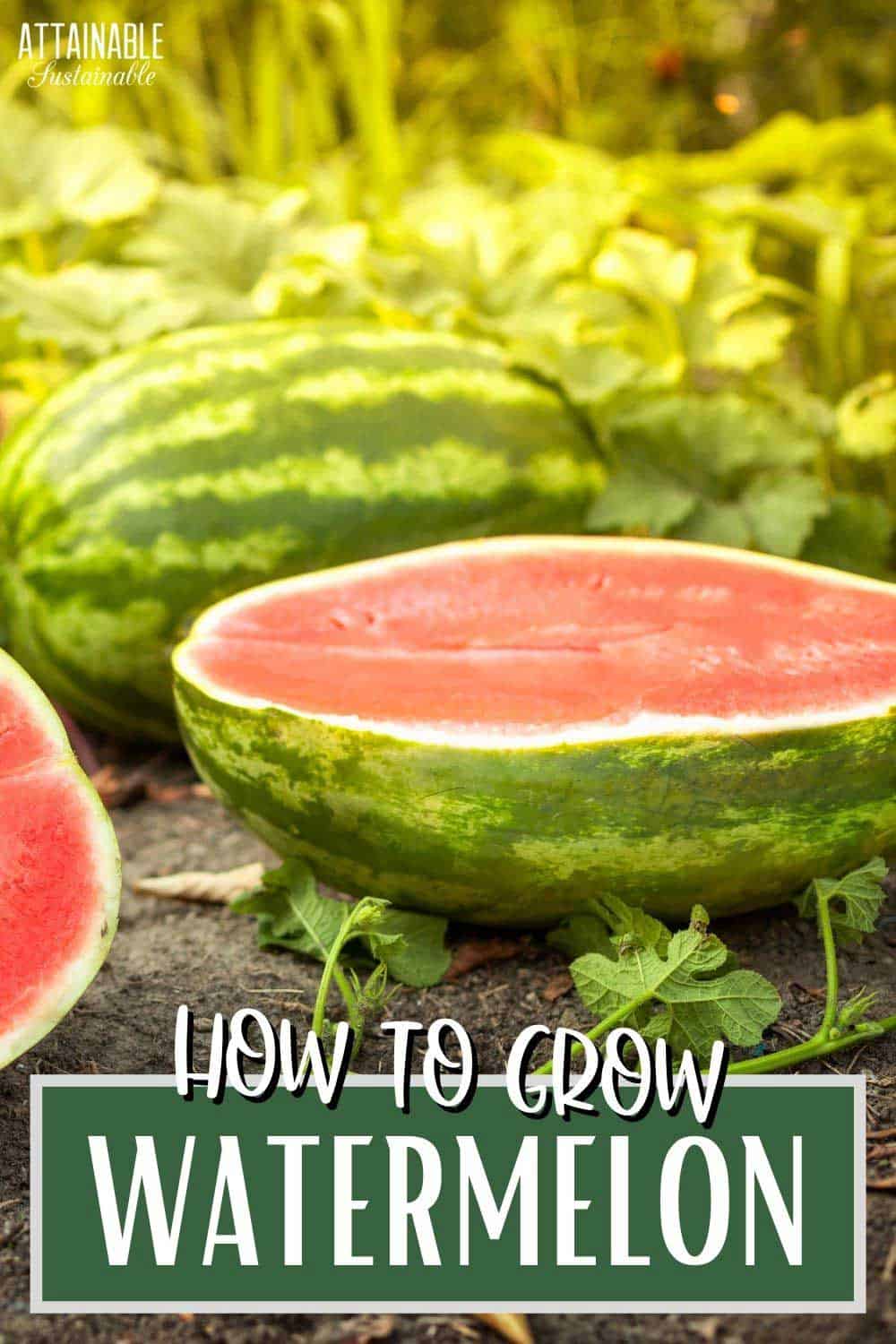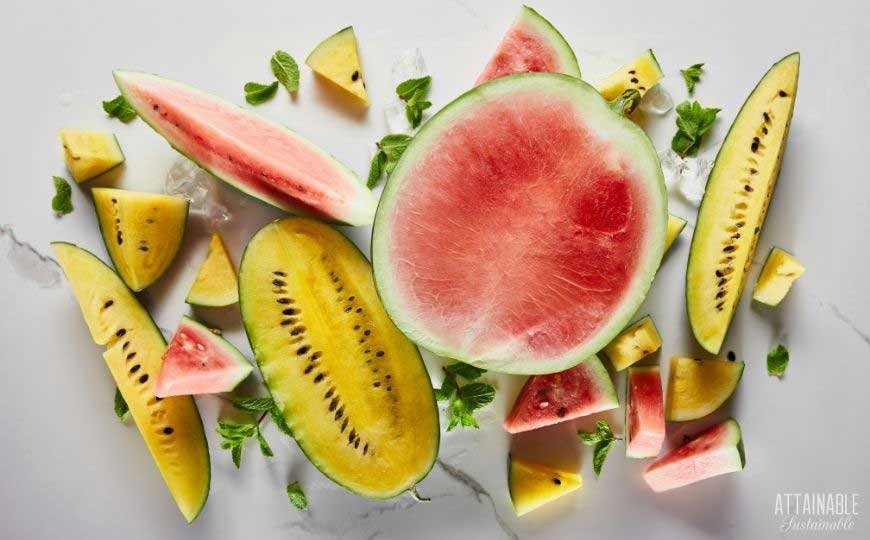Ever considered growing watermelon? If you’ve got the space, there’s nothing like harvesting one of these summertime fruits from your own backyard.
Really intent on harvesting fruit of your own? Consider adding a fruit tree to your place!
Contributed by Jodi Torpey, author and Master Gardener.

Watermelon, a native fruit from tropical Africa, is a member of the same gourd family as cucumbers. The familiar juicy fruits we all love have been around for thousands of years, starting out at wild plants.
With help from determined plant breeders, there’s now a large assortment of watermelons from striped and full of seeds to personal-sized melons that are seedless.
Introduction to Watermelon (Citrullus lanatus)
There are hundreds of melon varieties, but watermelons seem to be the ones most associated with hot summer days. Gardeners may plant cantaloupes, muskmelons and honeydews, but no melon compares to a slice of sweet, juicy watermelon at a Fourth of July picnic.
Grow Some Greens!
Ready to grow fresh greens, no matter WHERE you live? Sign up for my
FREE quick-start guide and start growing some of your own food!
Watermelons are warm-season fruits that typically need a long, hot growing season to produce the juiciest harvest. In addition to their sweet refreshing texture, watermelons have a good amount of vitamins A and C plus antioxidants.
Fortunately, watermelons are easy to grow at home, as long as you give the vines enough time and space to reach their potential.
A Watermelon for Every Garden
Watermelons come in all shapes, sizes and colors so there’s sure to be a variety that will fit in your garden. Because watermelons are most flavorful when they’re allowed to ripen on the vine, select the varieties that will mature in the shortest amount of time, which can range from 75-95 days. Depending on the variety, some plants may only produce a few large fruits for the season.
Need proof that watermelons are popular plants for home gardeners? All-America Selections, the plant trialing organization, has selected 15 different watermelons as “winners” over the years. Here’s an assortment of these watermelons to tantalize your tastebuds:
Faerie (2012 winner) is a small oval watermelon with creamy yellow rind and pink flesh; seedless. 60 days from transplants/72 days from seeds. Plants spread 11 feet.
Harvest Moon (2013 winner) is a round, dark green watermelon sprinkled with yellow dots (similar to the Moon and Stars variety); pink flesh and seedless. Watermelons grow on shorter vines that spread 3-5 feet; 80-100 days from transplants.
Mini-love (2017 winner) is a round, green striped, personal-sized watermelon with red flesh; 3-4 feet; 70 days from transplant/80 days from seed.
New Queen (1999 winner) is a round, dark green striped watermelon with bright orange flesh; 9 feet; 65-75 days from seeds or transplants.
Cal Sweet Bush (2019 winner) grows small round green fruits with pink flesh on compact bushy vines that are only 14-18 inches long; 65 days from transplants/90 days from seeds.
Popular Heirloom Varieties
Moon and Stars has a pattern of yellow spots on dark green rind with red flesh; 72-96-inch spread; 95-100 days to maturity.
Sugar Baby is an ice-box sized watermelon with green rind and bright red flesh; compact vines grow to 4 feet; 79 days to maturity.
How to Plant and Grow Watermelons
It’s important to plan where you’ll plant and grow your watermelon patch. Some varieties of watermelons need between 7 and 10 feet for vines to grow in all directions. Plan ahead to give vines room to grow, plus space to allow you to walk through the garden without walking on or over vines.
Another consideration for growing watermelon is how long it takes for the plants to grow and fruits to mature. Some varieties can take as long as 100 days of hot temperatures to ripen for a harvest. Select varieties that are advertised as “early” or “short-season” to make sure you have plenty of time to grow perfect melons.
To avoid timing issues, purchase or start your own melon transplants from seeds. Plant seeds indoors about 4-6 weeks before the average last frost date for your area. Some gardeners choose to plant watermelon seeds in peat pots that can be transplanted into the garden to avoid disturbing the delicate roots.
Wait for the soil to warm to at least 70 degrees before planting melon seeds or seedlings. In cold climates, this may mean waiting several weeks after the last average spring frost date or warming up the soil with plastic mulch to get a head start on planting. Avoid planting seeds or transplants in cool weather because cold soil can cause plants to stop growing, requiring time to recover.
Be sure to acclimate (harden off) tender transplants to the outside before transplanting in the garden. Over several days or even a week, gradually expose plants to sun and outside temperatures.
Plant transplants in a nutrient-rich, well-draining soil that’s been amended with compost. Space plants 3 to 5 feet apart, depending on the watermelon variety. Read planting instructions for the best information on spacing and don’t crowd your plants.
If direct sowing, plant 5-6 seeds in small hills or mounds that are spaced about 4-6 feet apart and cover seeds with about 1 inch of soil. After seeds sprout, you’ll need to thin each hill so that only the strongest 2 or 3 seedlings remain. Protect young seedlings from insects with floating row cloth or other cover until flowers start to form.
Set up a drip irrigation system or a soaker hose to ensure plants will get adequate water through the season. A layer of organic mulch will help maintain soil moisture and keep down weeds in the melon patch. Vines will start to grow upright, before they begin to run along the ground.
Requirements for Growing Watermelons
Watermelon plants have some specific requirements that need to be met in order to thrive.
Light Requirements
Locate the planting space for watermelons in full sun. The more sun, the better the watermelon crop.
Soil and Fertilizer Needs
Watermelons are known to be heavy feeders, so make sure plants get a continuous supply of fertilizer through the season. A well-balanced, slow-release fertilizer will keep plants healthy and lead to more flowers and fruits.
Water Requirements
Keep the soil consistently moist (not soggy) especially when the plants are setting fruit and growing. Water at the soil level, not overhead, to prevent common fungal diseases that form on wet leaves.
Handling Pests and Other Watermelon Problems
Watermelons need bees for pollination so plant flowers that attract bees near the watermelon patch.
Plant diseases can harm your watermelon crop, especially Anthracnose, a fungal disease. This disease shows up as yellow, water-soaked spots on leaves that turn black. Remove any infected vines or leaves and check with your county’s cooperative extension office for specific controls in your area.
Insect pests include aphids, so examine plants every day, looking on the vines and under leaves. If you see aphids, treat them with a strong blast of water from the hose or an insecticidal soap.
Harvesting Watermelon
Timing the harvest for ripe and juicy fruits depends on the watermelon variety you planted. Watermelons are usually ready about 8-10 weeks after they’ve flowered. Keep track of the days-to-maturity for the melons you planted.
When it’s getting close to harvest time, check to make sure the melons’ ground-spot is yellow, not white and that the skin is dull and not shiny. Another indicator of maturity is when you gently tap the melon, you hear a dull thud or “thunk.”
Use a sharp knife to cut watermelons from the vines, leaving a bit of stem.
How to Grow Watermelons in Containers
You can plant and grow watermelons in containers if you select a bush, dwarf variety or variety with vines that can grow in a limited amount of space. Some, like Cal Sweet Bush, will produce one or two watermelons when grown in a container.
Use a large container, like a half-barrel with a mixture of potting soil and compost. Be sure to keep vines off of the ground with a sturdy trellis and use cloth or fabric to support the growing fruits.
Unusual Ideas for Using Fresh Watermelon
Before cutting into your watermelons, always wash them to prevent spreading any soil or bacteria from the garden into the flesh.
The best way to eat watermelon is to slice, savor and let the juice dribble down your chin. For more sophisticated eating, scoop out the flesh, cut fancy edges onto the empty rind and fill the bowl with melon balls.
Other ideas:
- Grill watermelon slices
- Roast watermelon seeds in the oven
- Make pickled watermelon rind
- Freeze or use fresh for frozen drinks
Saving Watermelon Seeds
If you want to save watermelon seeds of a specific variety for the future, plan ahead. Plant one variety of an heirloom or open-pollinated watermelon and isolate it from other melons to prevent cross-pollination.
When ripe, remove, rinse and strain seeds and let them dry thoroughly on a screen or paper plate, then keep in an airtight container. Store in a cool, dark and dry place until it’s time to plant for the next watermelon season.








